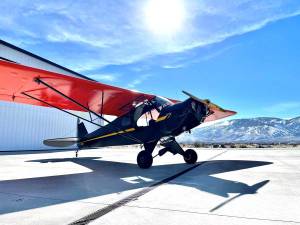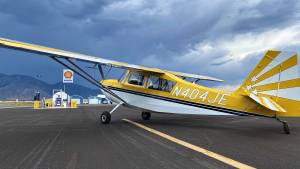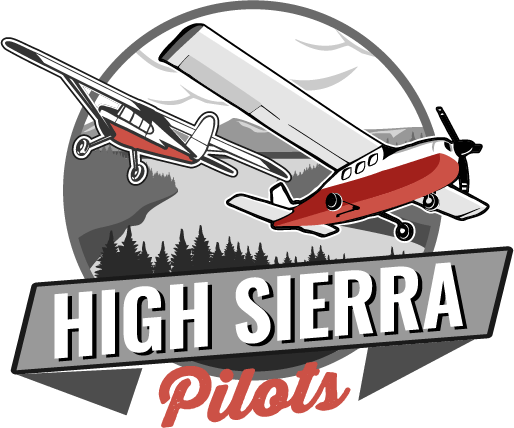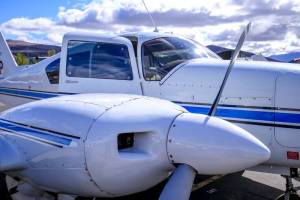What Can You Get At HSP?

- A minimum of 20 hours of flight time comprising of:
- 15 hours of flight training from an authorized instructor.
- 5 hours of solo flight.
- Flight training must include at least:
- 2 hours of cross-country flight training.
- 10 takeoffs and landings to a full stop.
- One solo cross-country flight of at least 75 nautical miles total distance with a full-stop landing at a minimum of two points and one segment of the flight consisting of a straight-line distance of at least 25 nautical miles between takeoff and landing locations.
- 2 hours of flight training in preparation for the practical test.
- Ground training from an instructor or home-study course.
- FAA knowledge test on applicable aeronautical knowledge areas.
- FAA practical test for the applicable light-sport aircraft privilege.
- Allows you to fly almost anywhere in the United States and even outside the United States when you comply with regulations of the foreign country where the aircraft is operated.
- You can carry (and share expenses with) as many passengers as your aircraft will legally allow.
- Fly at altitudes up to 18,000 feet.
- Operate under Visual Flight Rules (VFR). You must earn an instrument rating to fly in clouds or other weather conditions that require navigation solely by reference to instruments.
- You can fly at night under VFR.
- You will be required to maintain currency and medical requirements for proficiency and health.
- Most pilots start out with their private pilot certificates.
Private Pilot Certificate Requirements:
- Minimum of 40 hours of flight time
- 20 hours of dual flight time
- 3 hours cross country
- 3 hours instrument
- 3 hours at night
- 1-night cross country over 100 nm
- 10-night takeoffs and landings
- 3 hours of check-ride prep
- 10 hours of solo flight time
- 5 hours solo cross country
- 1 solo cross country > 150 nm with 3 landings
- Pass written exam (minimum score of 70%)
- Practical exam “check-ride” with FAA Designated Pilot Examiner
- 50 Hours of cross-country “Pilot in Command” flight time
- Min 10 hours in the airplane
- 40 hours of actual or simulated instrument time
- Minimum of 15 Hours received from an Instrument Rated Instructor
- Minimum of 3 Hours of instrument flight training from an instructor within 2 calendar months before the practical exam
- Min 1 IFR cross-country Flight with a flight plan filed with ATC
- Flight must be at least 250 nm along Airways or by direct routing from ATC
- Three different kinds of approaches with the use of a navigation system
- An instrument approach at each airport
- Pass written exam (minimum score of 70%)
- Practical exam “check-ride” with FAA Designated Pilot Examiner
- Under CFR 14 Part 61.31, you must receive tailwheel training from an authorized instructor. The instructor’s endorsement will find you proficient in the operation of the aircraft. Yet, the FAA spells out the following minimum maneuvers and procedures:
- Normal and crosswind takeoffs and landings;
- Wheel landings, and
- Go around procedures
There is no minimum number of hours required to achieve a tailwheel endorsement. However, it takes an average of 7 to 12 hours of flight time for most pilots to get it. As always with flying, much depends on your abilities and your frequency of flying. With tailwheel endorsements, I wouldn’t be focusing on time, but rather focus on competence.
- Depending on your proficiency it could take as little as 1 to over 10 hours of flight training, though 2-4 hours is common. Many pilots combine high-performance and complex endorsements since many aircraft check both boxes.
- Depending on your proficiency it could take as little as 1 to over 10 hours of flight training, though 2-4 hours is common. Many pilots combine high-performance and complex endorsements since many aircraft check both boxes.
- 250 hours of flight time, 100 hours of which must be in powered aircraft, and 50 must be in airplanes.
- 100 hours of pilot-in-command time, 50 of which must be in airplanes.
- 50 hours of cross-country time, 10 of which must be in an airplane.
- 20 hours of training, including 10 of the instrument, 10 of complex or TAA, and a smattering of cross-country and practical test preparation.
- 10 hours of solo training, including a smattering of cross-country and night.
Additional class ratings, such as adding a multiengine rating to a single-engine commercial pilot certificate or adding a single-engine rating to a multiengine commercial pilot certificate, will take additional training in that class. FAR 61.129 has all the specifics.
The pilot seeking a multi-engine rating must have a current Federal Aviation Administration (FAA) medical and provide citizenship proof or have TSA approval. They are required to already have a license as a single-engine pilot.
Requirements:
High Sierra Pilots Multi-Engine training curriculum teaches the aerodynamic differences between the single and the multi-engine plane and provides the proper instruction needed to pass the multi-engine check-ride. While there are no specific hour requirements for adding a multi-engine rating to a certificate, typically most pilots will require about 10 hours of flight training to reach the proficiency required to pass the practical test. The FAA requires training in the following specific areas:
- Preflight preparation
- Preflight procedures
- Airport operations
- Takeoffs, landings, and go-arounds
- Performance maneuvers
- Navigation
- Slow flight and stalls
- Emergency operations
- Multi-engine operations
As with all flight training, preparing for a multi-engine rating requires both ground and flight training.
High Sierra Pilots has a beautiful Piper Aztec to get your Multi-Engine rating in.
- Be 18 years of age.
- Hold either a commercial pilot certificate with an instrument rating.
- Have logged at least 250 hours of flight time.
- Hold a valid FAA 3rd Class Medical Certificate (or higher)
- Pass the Fundamentals of Instruction written test.
- Pass the Flight Instructor Aeronautical Knowledge test.
- Pass the CFI Checkride (flight test).
The CFII requires you receive the proper ground instruction to be able to teach the instrument skills to students, a knowledge test, and another Checkride with a DPE. This pattern is repeated with the MEI except it all pertains to Multi-Engine Instrument teaching and you must have 10 hours PIC in a Multi-Engine Airplane.

for pilots to have upset prevention and recovery training (UPRT), which helps equip them to promptly recognize an escalating threat pattern or sensory overload, and quickly identify and correct an impending upset. Part of this training
should include practicing certain stick-and-rudder skills like slow flight, stalls, spins, and unusual attitudes. At High Sierra Pilots, we have a Super Decathlon
that’s perfect for this type of training. And as a bonus, if you like you can also learn some aerobatics.

